A Direct Single-Phase to Three-Phase AC/AC Power Converter
Abstract
:1. Introduction
- Employs single-stage power conversion;
- Can perform multiple order frequency conversion by changing the gate signals only;
- Mitigates the output voltage THD;
- Utilizes line frequency switching instead of high-frequency switching, which aids to reduces the power loss of the converter;
- Reduces the magnitude of detrimental lower-order harmonics;
- Can be used to drive low-cost three-phase induction motors in the industry from single-phase supply;
- Reduces the overall cost and circuit complexity due to the use of TRIAC instead of SCR;
- Can be used to drive a low-power three-phase traction motor from a single-phase supply;
- Can be considered the best candidate for the farmers to run their three-phase induction motor-driven water pump where only single-phase utility is available.
2. Proposed AC/AC Power Converter
2.1. Topology of the Proposed AC/AC Power Converter
2.2. Operating Principle of the Proposed AC/AC Converter
2.3. Performance Analysis of the Proposed AC/AC Power Converter
3. Experimental Validation
4. Analytical Harmonics Analysis for the Proposed AC/AC Power Converter
5. Result Analysis and Comparisons
6. Conclusions
Author Contributions
Funding
Data Availability Statement
Conflicts of Interest
References
- Jibhakate, C.; Chaudhari, M.; Renge, M. A Reduced Switch AC-AC Converter with the Application of D-STATCOM and Induction Motor Drive. Electronics 2018, 7, 110. [Google Scholar] [CrossRef] [Green Version]
- Barrios, M.A.; Cárdenas, V.; Sandoval, J.M.; Guerrero, J.M.; Vasquez, J.C. A Cascaded DC-AC-AC Grid-Tied Converter for PV Plants with AC-Link. Electronics 2021, 10, 409. [Google Scholar] [CrossRef]
- Varajão, D.; Araújo, R.E. Modulation Methods for Direct and Indirect Matrix Converters: A Review. Electronics 2021, 10, 812. [Google Scholar] [CrossRef]
- Szczesniak, P. Challenges and Design Requirements for Industrial Applications of AC/AC Power Converters without DC-Link. Energies 2019, 12, 1581. [Google Scholar] [CrossRef] [Green Version]
- Vishnuram, P.; Dayalan, S.; Thanikanti, S.B.; Balasubramanian, K.; Nastasi, B. Single Source Multi-Frequency AC-AC Converter for Induction Cooking Applications. Energies 2021, 14, 4799. [Google Scholar] [CrossRef]
- Afshari, E.; Khodabandeh, M.; Amirabadi, M. A Single-Stage Capacitive AC-Link AC–AC Power Converter. IEEE Trans. Power Electron. 2019, 34, 2104–2118. [Google Scholar] [CrossRef]
- Liu, C.; Guo, D.; Shan, R.; Cai, G.; Ge, W.; Huang, Z.; Wang, Y.; Zhang, H.; Wang, P. Novel Bipolar-Type Direct AC–AC Converter Topology Based on Non-Differential AC Choppers. IEEE Trans. Power Electron. 2019, 34, 9585–9599. [Google Scholar] [CrossRef]
- Ma, D.; Chen, W.; Shu, L.; Qu, X.; Gao, S.; Hou, K. A Multiport AC–AC–DC Converter for Soft Normally Open Point. IEEE Trans. Circuits Syst. II Express Br. 2022, 69, 2146–2150. [Google Scholar] [CrossRef]
- Wang, H.; Blaabjerg, F. Reliability of capacitors for DC-Link applications in power electronic converters—An overview. IEEE Trans. Ind. Appl. 2014, 50, 3569–3578. [Google Scholar] [CrossRef] [Green Version]
- Diab, M.S.; Elserougi, A.A.; Abdel-Khalik, A.S.; Massoud, A.M.; Ahmed, S. A Nine-Switch-Converter-Based Integrated Motor Drive and Battery Charger System for EVs Using Symmetrical Six-Phase Machines. IEEE Trans. Ind. Electron. 2016, 63, 5326–5335. [Google Scholar] [CrossRef]
- Liu, C.; Wu, B.; Zargari, N.; Xu, D. A novel nine-switch PWM rectifier-inverter topology for three-phase UPS applications. In Proceedings of the 2007 European Conference on Power Electronics and Applications, Aalborg, Denmark, 2–5 September 2007; pp. 1–10. [Google Scholar]
- Alves, W.C.; Morais, L.M.F.; Cortizo, P.C. Design of an Highly Efficient AC-DC-AC Three-Phase Converter Using SiC for UPS Applications. Electronics 2018, 7, 425. [Google Scholar] [CrossRef] [Green Version]
- Komarzyniec, G.; Aftyka, M. Operating Problems of Arc Plasma Reactors Powered by AC/DC/AC Converters. Appl. Sci. 2020, 10, 3295. [Google Scholar] [CrossRef]
- Petrauskas, G.; Svinkunas, G. Application of Single-Phase Supply AC-DC-AC VFD for Power Factor Improvement in LED Lighting Devices Loaded Power Distribution Lines. Appl. Sci. 2022, 12, 5955. [Google Scholar] [CrossRef]
- Petrauskas, G.; Svinkunas, G.; Jonaitis, A.; Giannakis, A. Application of Novel AC–AC Matrix VFD for Power Factor Improvement in Conventional AC–DC–AC VFD-Loaded Power Distribution Lines. Electronics 2022, 11, 997. [Google Scholar] [CrossRef]
- Kolar, J.W.; Friedli, T.; Rodriguez, J.; Wheeler, P.W. Review of three-phase PWM AC–AC converter topologies. IEEE Trans. Ind. Electron. 2011, 58, 4988–5006. [Google Scholar] [CrossRef]
- Szcze’sniak, P.; Kaniewski, J.; Jarnut, M. AC/AC power electronic converters without DC energy storage: A review. Energy Convers. Manag. 2015, 92, 483–497. [Google Scholar] [CrossRef]
- Empringham, L.; Kolar, J.W.; Rodriguez, J.; Wheeler, P.W.; Clare, J.C. Technological issues and industrial application of matrix converters: A review. IEEE Trans. Ind. Electron. 2013, 60, 4260–4271. [Google Scholar] [CrossRef]
- Abo-Khalil, A.G.; Alyami, S.; Alhejji, A.; Awan, A.B. Real-Time Reliability Monitoring of DC-Link Capacitors in Back-to-Back Converters. Energies 2019, 12, 2369. [Google Scholar] [CrossRef] [Green Version]
- Plazas-Rosas, R.A.; Orozco-Gutierrez, M.L.; Spagnuolo, G.; Franco-Mejía, É.; Petrone, G. DC-Link Capacitor Diagnosis in a Single-Phase Grid-Connected PV System. Energies 2021, 14, 6754. [Google Scholar] [CrossRef]
- Ashraf, N.; Abbas, G.; Ullah, N.; Alzaed, A.N.; Raza, A.; Raza, M.T.; Farooq, U. A New Dual Polarity Direct AC-AC Voltage Regulator Ensuring Voltage Step-Up and Step-Down Capabilities. Appl. Sci. 2021, 11, 11944. [Google Scholar] [CrossRef]
- Ashraf, N.; Abbas, G.; Ullah, N.; Alahmadi, A.A.; Awan, A.B.; Zubair, M.; Farooq, U. A Simple Two-Stage AC-AC Circuit Topology Employed as High-Frequency Controller for Domestic Induction Heating System. Appl. Sci. 2021, 11, 8325. [Google Scholar] [CrossRef]
- Wang, R.; Huang, M.; Lu, C.; Wang, W. A Direct Three-Phase AC–AC Matrix Converter-Based Wireless Power Transfer System for Electric Vehicles. Appl. Sci. 2020, 10, 2217. [Google Scholar] [CrossRef] [Green Version]
- Sadeghi, Z.; Shahparasti, M.; Rajaei, A.; Laaksonen, H. Three-Level Reduced Switch AC/DC/AC Power Conversion System for High Voltage Electric Vehicles. Sustainability 2022, 14, 1620. [Google Scholar] [CrossRef]
- Mahanta, A.; Biswas, S.P. THD Reduction of Single-Phase to Single-Phase Step-Down Cycloconverter Using Multiwinding Transformer. In Proceedings of the 2019 5th International Conference on Advances in Electrical Engineering (ICAEE), Dhaka, Bangladesh, 26–28 September 2019; pp. 108–112. [Google Scholar] [CrossRef]
- Ashraf, N.; Abbas, G.; Ullah, N.; Al-Ahmadi, A.A.; Raza, A.; Farooq, U.; Jamil, M. Investigation of the Power Quality Concerns of Input Current in Single-Phase Frequency Step-Down Converter. Appl. Sci. 2022, 12, 3663. [Google Scholar] [CrossRef]
- Abu-Siada, A.; Budiri, J.; Abdou, A.F. Solid State Transformers Topologies, Controllers, and Applications: State-of-the-Art Literature Review. Electronics 2018, 7, 298. [Google Scholar] [CrossRef] [Green Version]
- Lumbreras, D.; Gálvez, E.; Collado, A.; Zaragoza, J. Trends in Power Quality, Harmonic Mitigation and Standards for Light and Heavy Industries: A Review. Energies 2020, 13, 5792. [Google Scholar] [CrossRef]
- Rahman, K.; Al-Emadi, N.; Iqbal, A.; Rahman, S. Common mode voltage reduction technique in a three-to-three phase indirect matrix converter. IET Electr. Power Appl. 2018, 12, 254–263. [Google Scholar] [CrossRef]
- Friedli, T.; Kolar, J.W. Milestones in Matrix Converter Research. IEEE J. Ind. Devices Appl. 2012, 1, 2–14. [Google Scholar] [CrossRef] [Green Version]
- Uddin, M.S.; Biswas, S.P.; Islam, M.R.; Anower, M.S.; Kouzani, A.Z.; Mahmud, M.A.P. A New Generalized Step-Down Single-Stage AC/AC Power Converter. Sustainability 2020, 12, 9181. [Google Scholar] [CrossRef]
- Basic, D.; Ramsden, V.S.; Muttik, P.K. Selective compensation of cycloconverter harmonics and inter harmonics by using a hybrid power filter system. In Proceedings of the 2000 IEEE 31st Annual Power Electronics Specialists Conference, Galway, Ireland, 23–23 June 2000; pp. 1137–1142. [Google Scholar]
- Taufik, T.; Adamson, J.; Prabuwono, A.S. Pulse density modulated soft-switching single-phase cycloconverter. In Proceedings of the 2011 IEEE Applied Power Electronics Colloquium (IAPEC), Johor Bahru, Malaysia, 18–19 April 2011; pp. 189–194. [Google Scholar]
- Mazumder, S.K.; Rathore, A.K. Primary-Side-Converter-Assisted Soft-Switching Scheme for an AC/AC Converter in a Cycloconverter-Type High-Frequency-Link Inverter. IEEE Trans. Ind. Electron. 2011, 58, 4161–4166. [Google Scholar] [CrossRef]
- Babaei, E.; Heris, A.A. PWM-based control strategy for forced commutated cycloconverters. In Proceedings of the 2009 IEEE Symposium on Industrial Electronics & Applications, Kuala Lumpur, Malaysia, 4–6 October 2009; pp. 669–674. [Google Scholar]
- Agarwal, V.; Agarwal, A. FPGA based delta modulated cyclo-converter. In Proceedings of the 2011 5th International Power Engineering and Optimization Conference, Shah Alam, Selangor, Malaysia, 6–7 June 2011; pp. 301–305. [Google Scholar]
- Yan, Z.; Xu, S.; Han, X.; Sun, X.; Li, J. A novel de-re-couple modulation strategy for full-wave mode single-phase high-frequency link inverter. In Proceedings of the 2014 IEEE Transportation Electrification Conference & Expo Asia-Pacific (ITEC Asia-Pacific), Beijing, China, 31 August–3 September 2014; pp. 1–4. [Google Scholar]
- Ashraf, N.; Hanif, A.; Farooq, U.; Asad, M.U.; Rafiq, F. Half cycle pairs method for harmonic analysis of cycloconverter voltage waveform. In Proceedings of the 2013 International Conference on Open Source Systems and Technologies, Lahore, Pakistan, 16–18 December 2013; pp. 97–102. [Google Scholar]
- Agarwal, A.; Agarwal, V. Harmonic reduction in AC to AC converter by trapezoidal modulation technique. In Proceedings of the 2009 International Conference on Power Systems, Kharagpur, India, 27–29 December 2009; pp. 1–6. [Google Scholar]
- Agarwal, A.; Agarwal, V. Design of delta-modulated generalized frequency converter. IEEE Trans. Ind. Electron. 2010, 57, 3724–3729. [Google Scholar] [CrossRef]
- Khedekar, A.; Badade, D.; Ugawekar, H.; Kale, S.; Kulkarni, R.D.; Kumari, M. Simulation of single phase to single phase step down cycloconverter for industrial application. In Proceedings of the 2019 International Conference on Nascent Technologies in Engineering (ICNTE), Navi Mumbai, India, 4–5 January 2019; pp. 1–6. [Google Scholar]
- Idris, Z.; Hamzah, M.K. Implementation of a new single-phase cycloconverter based on single-phase matrix converter topology using sinusoidal pulse width modulation with passive load condit. In Proceedings of the 2006 1ST IEEE Conference on Industrial Electronics and Applications, Singapore, 24–26 May 2006; pp. 1–6. [Google Scholar]
- Biswas, A.; Chaudhari, S. Harmonic reduction in single phase AC-AC converter. Indian J. Sci. Technol. 2017, 10, 1–7. [Google Scholar]
- Islam, T.; Fayek, H.H.; Rusu, E.; Rahman, F. Triac based novel single phase step-down cycloconverter with reduced THDs for variable speed applications. Applied Sciences 2021, 11, 8688. [Google Scholar] [CrossRef]

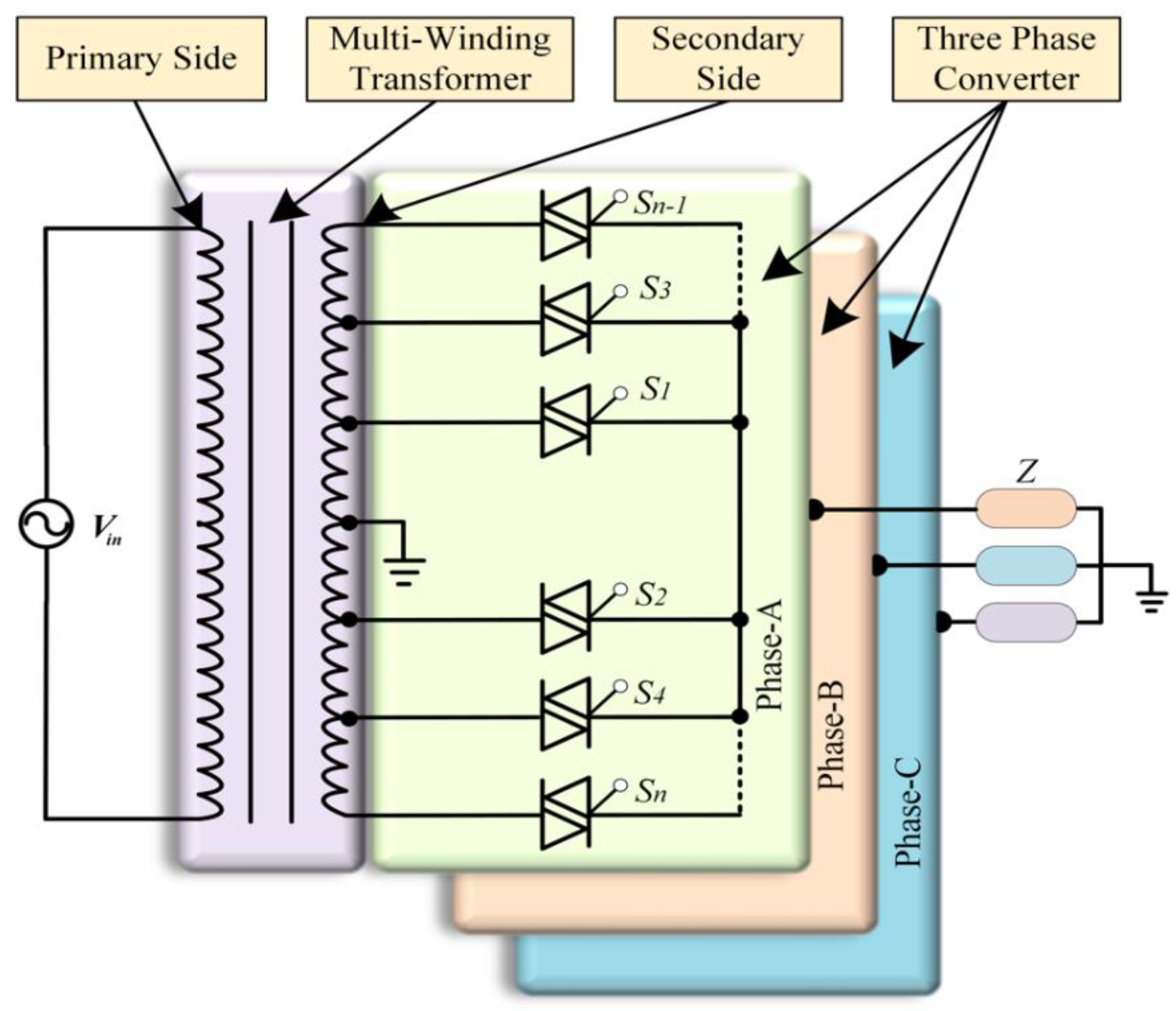
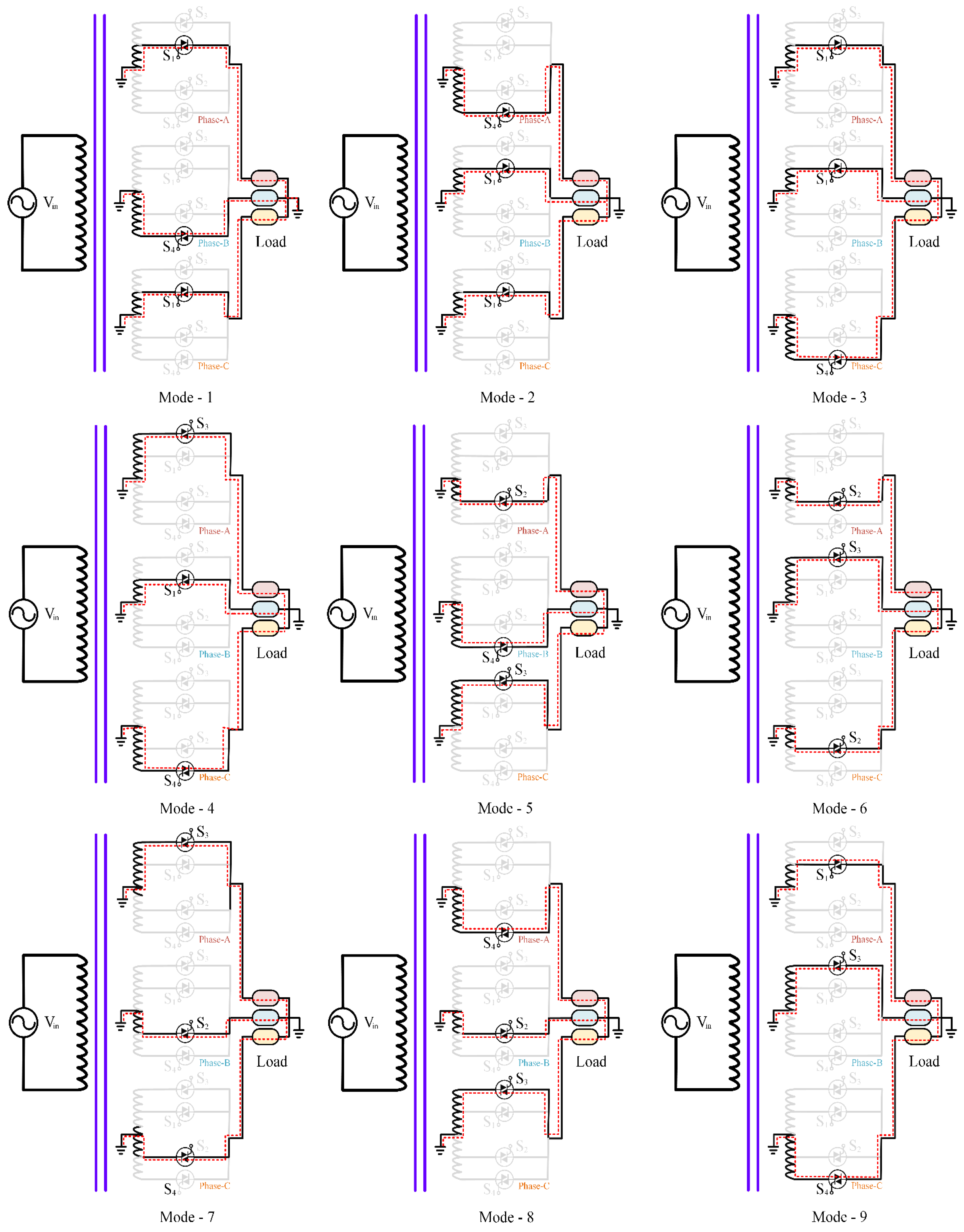

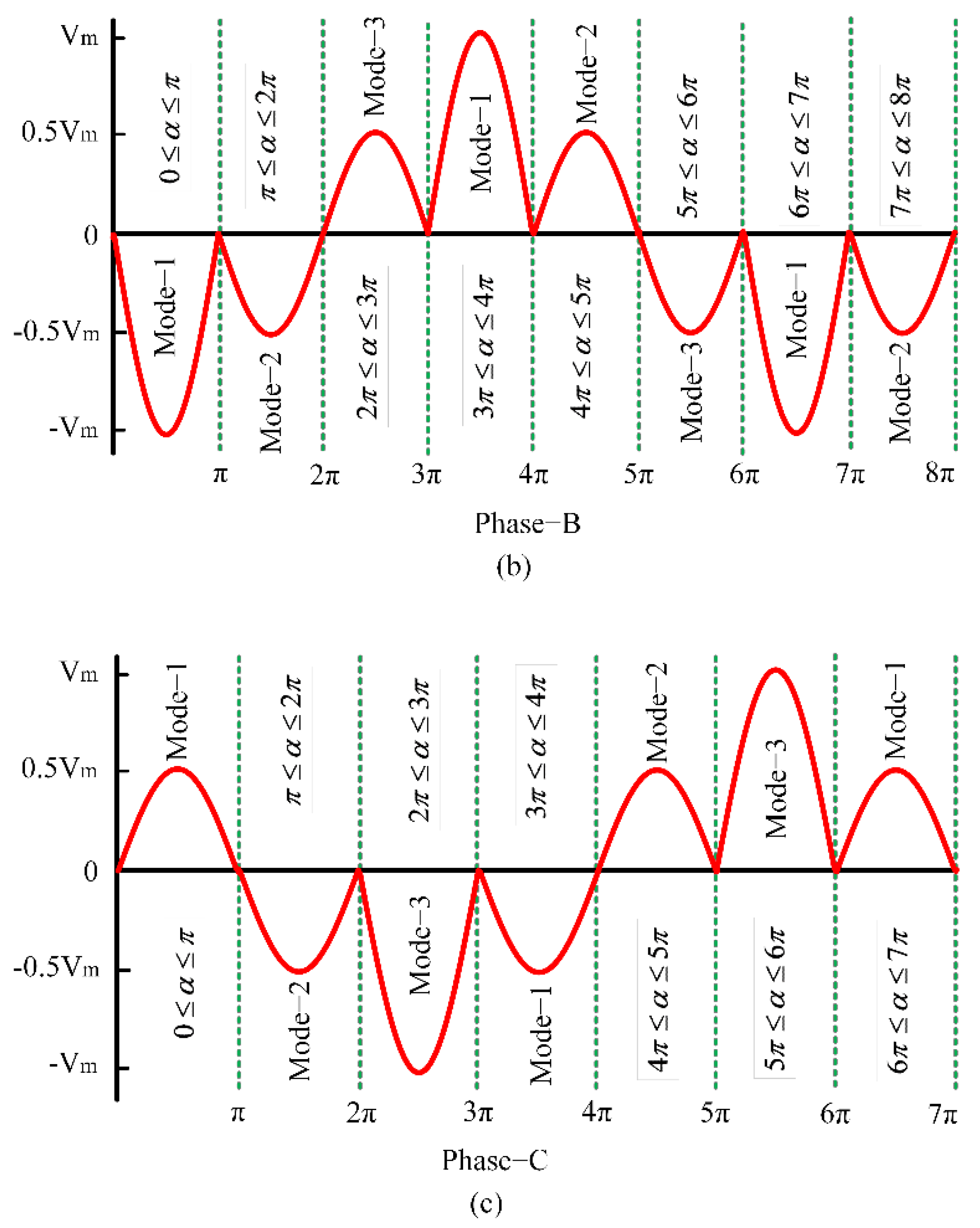
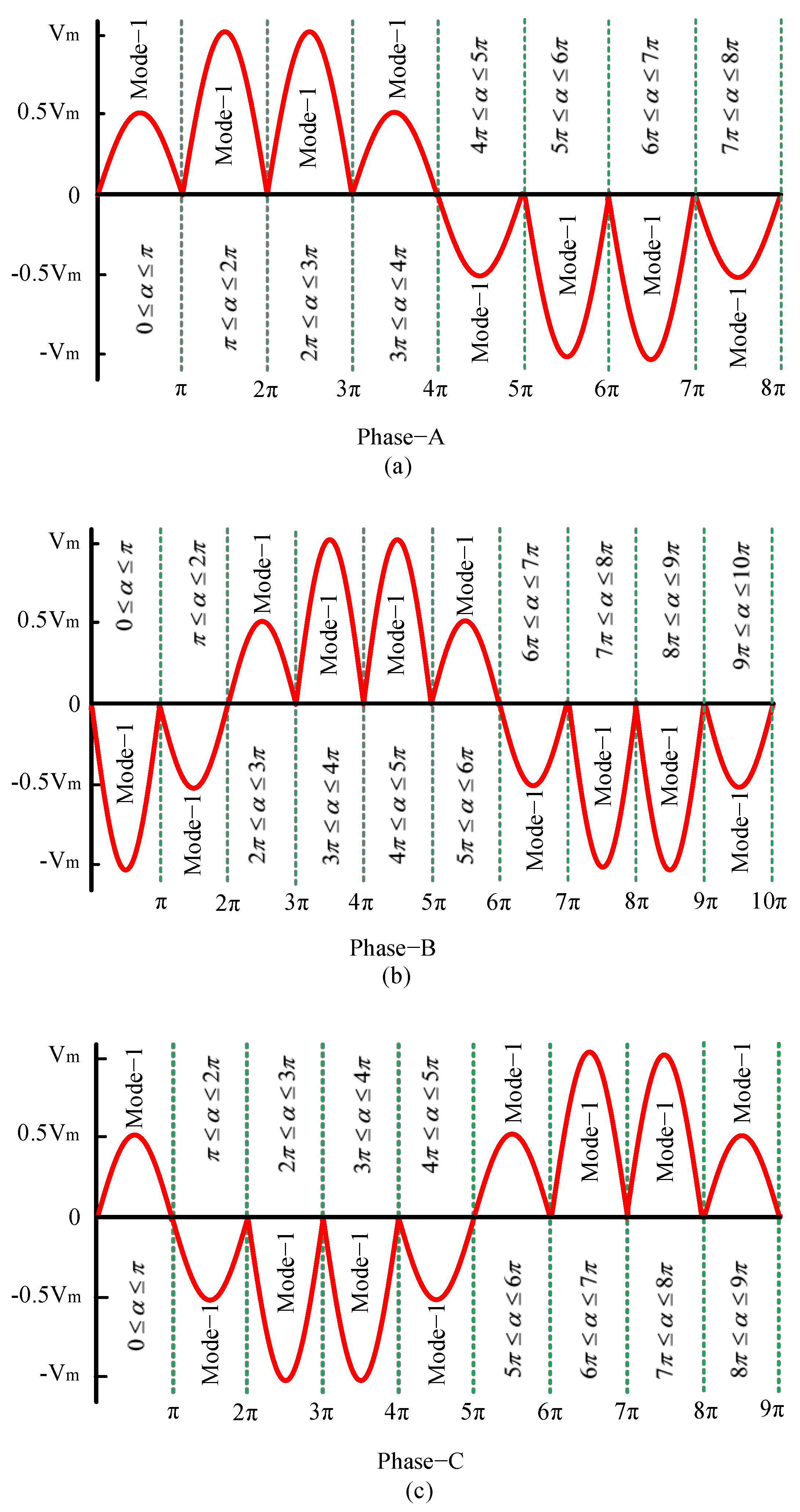
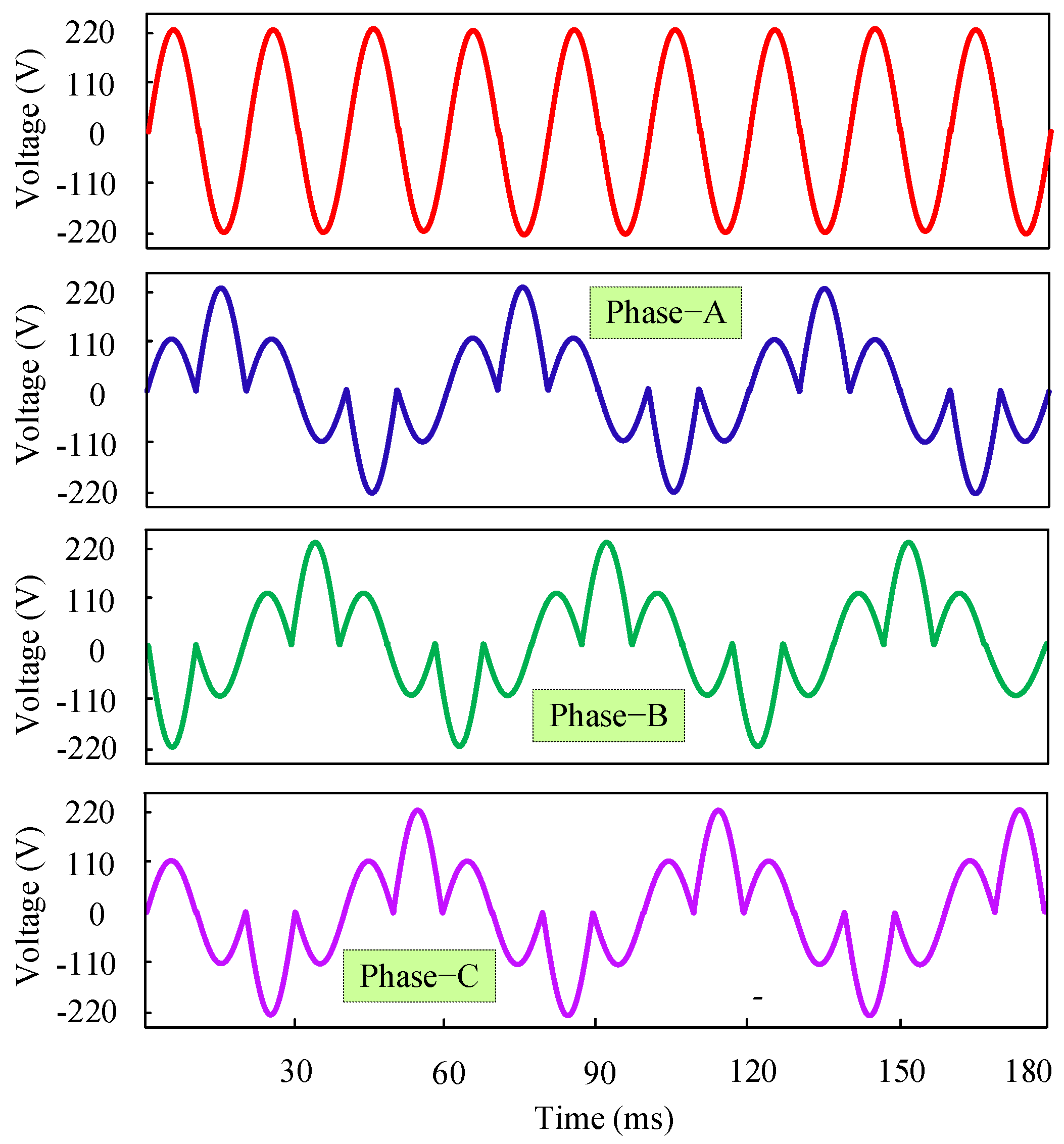
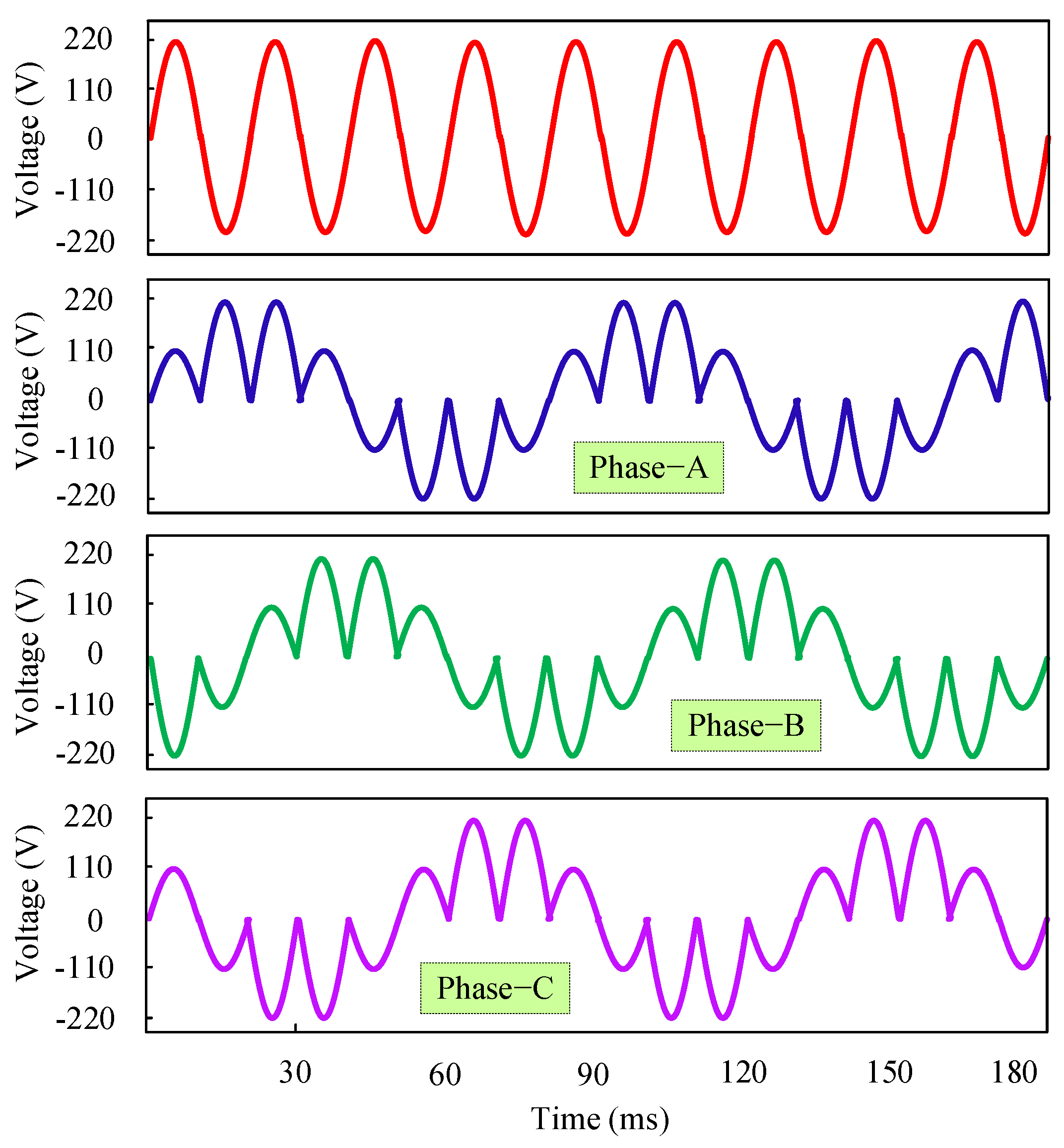
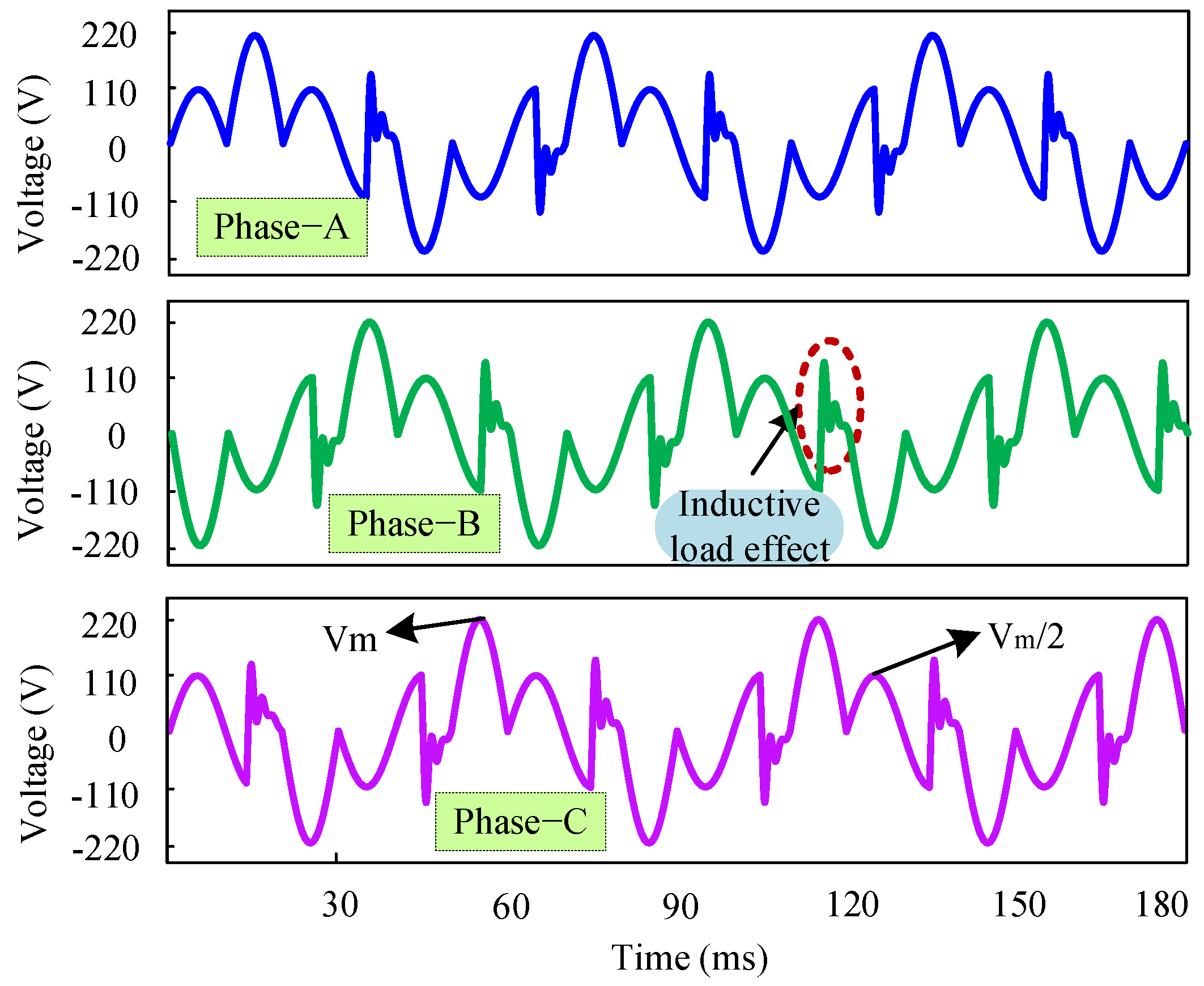


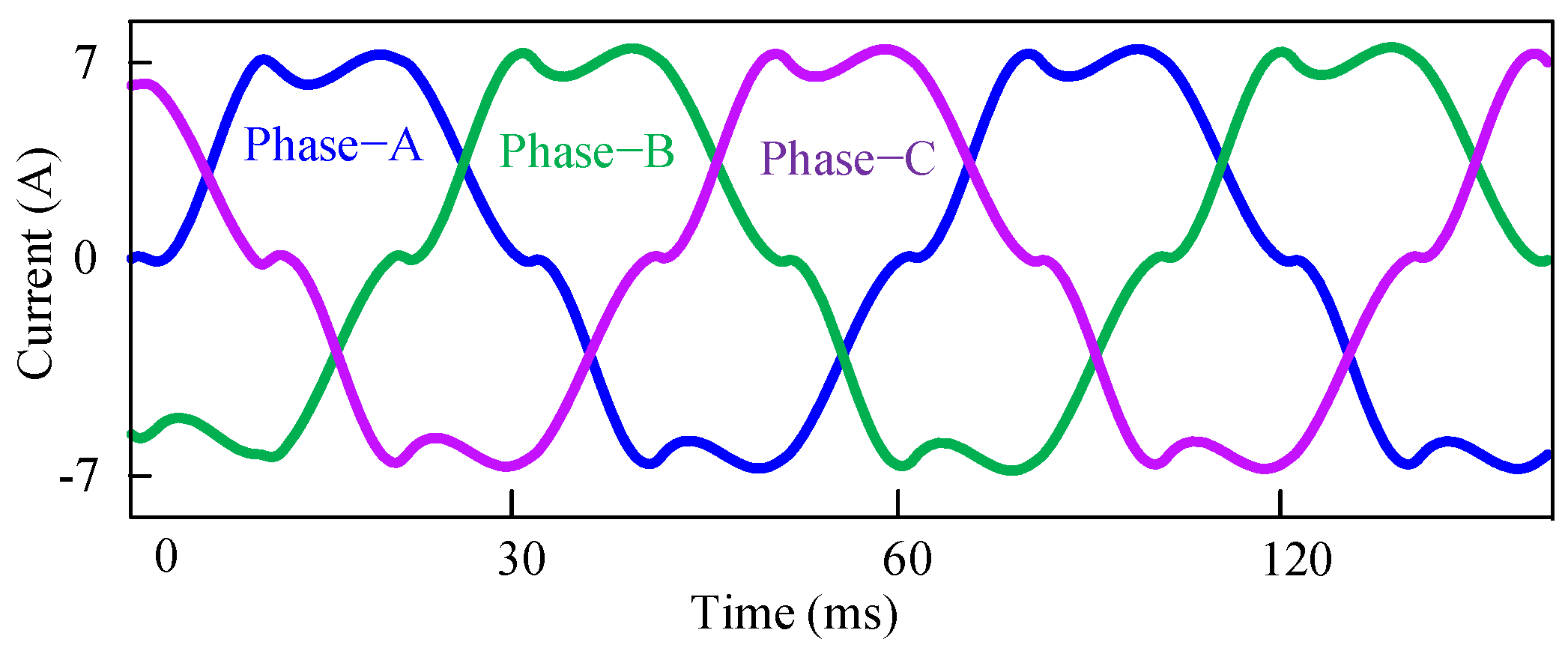

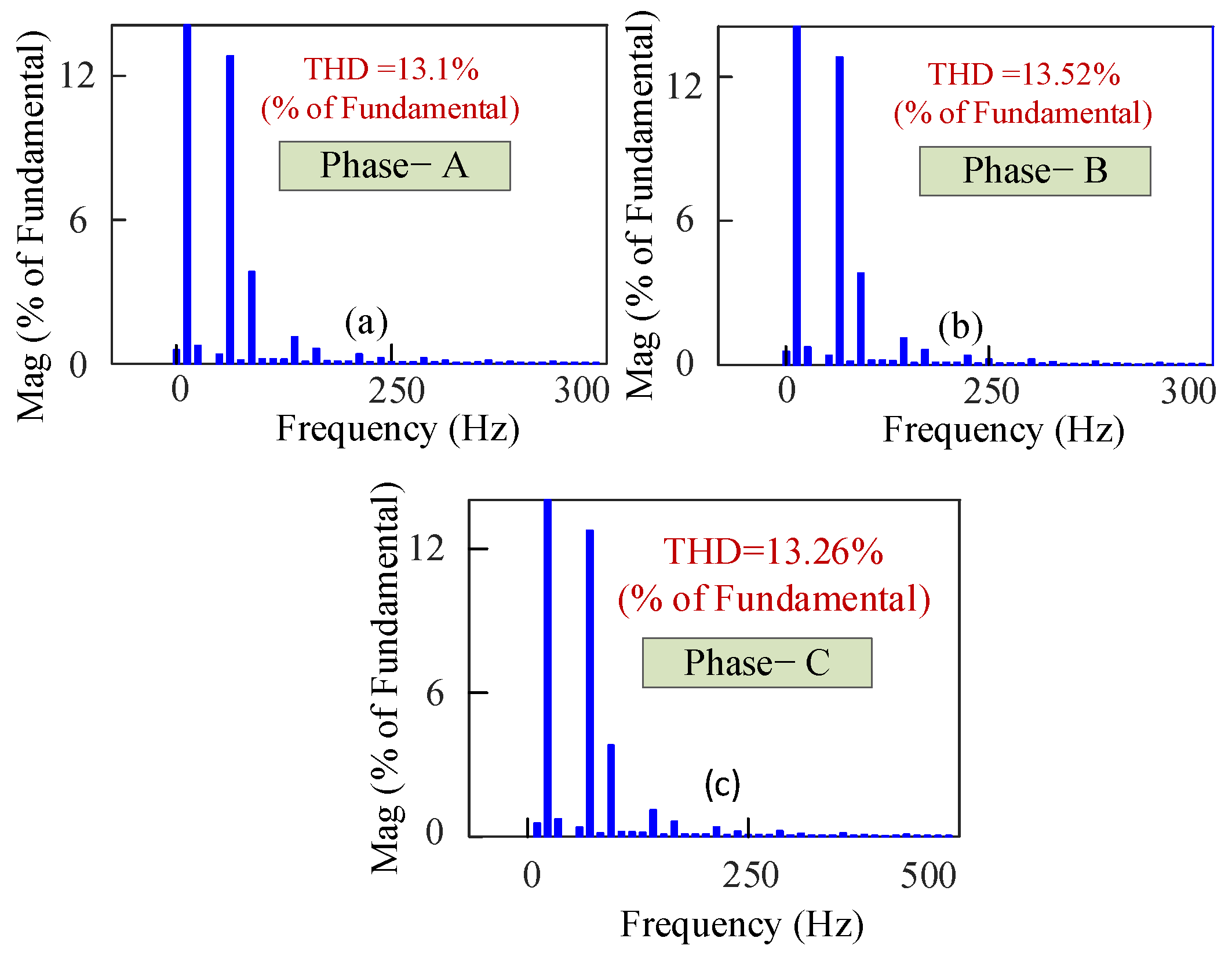
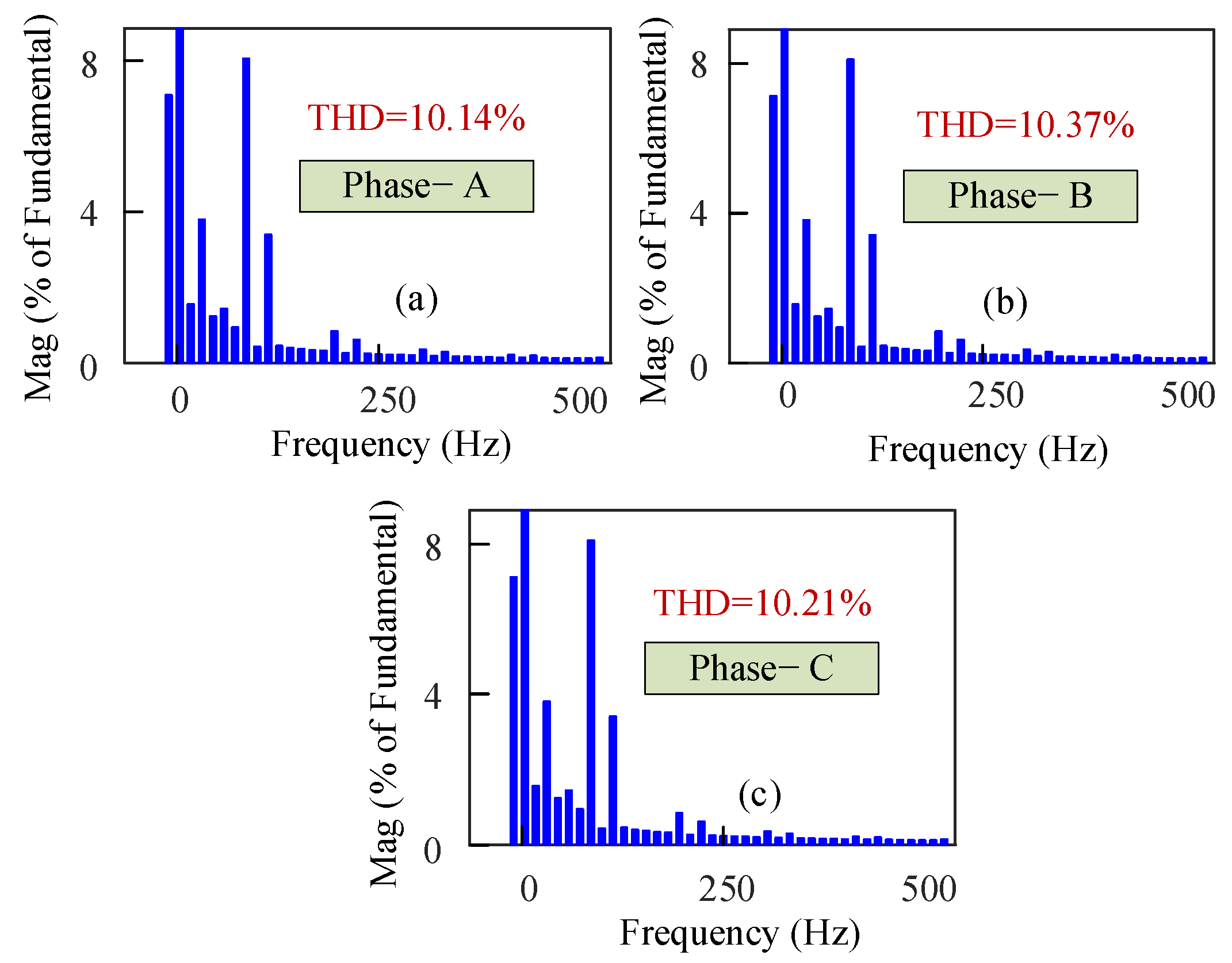

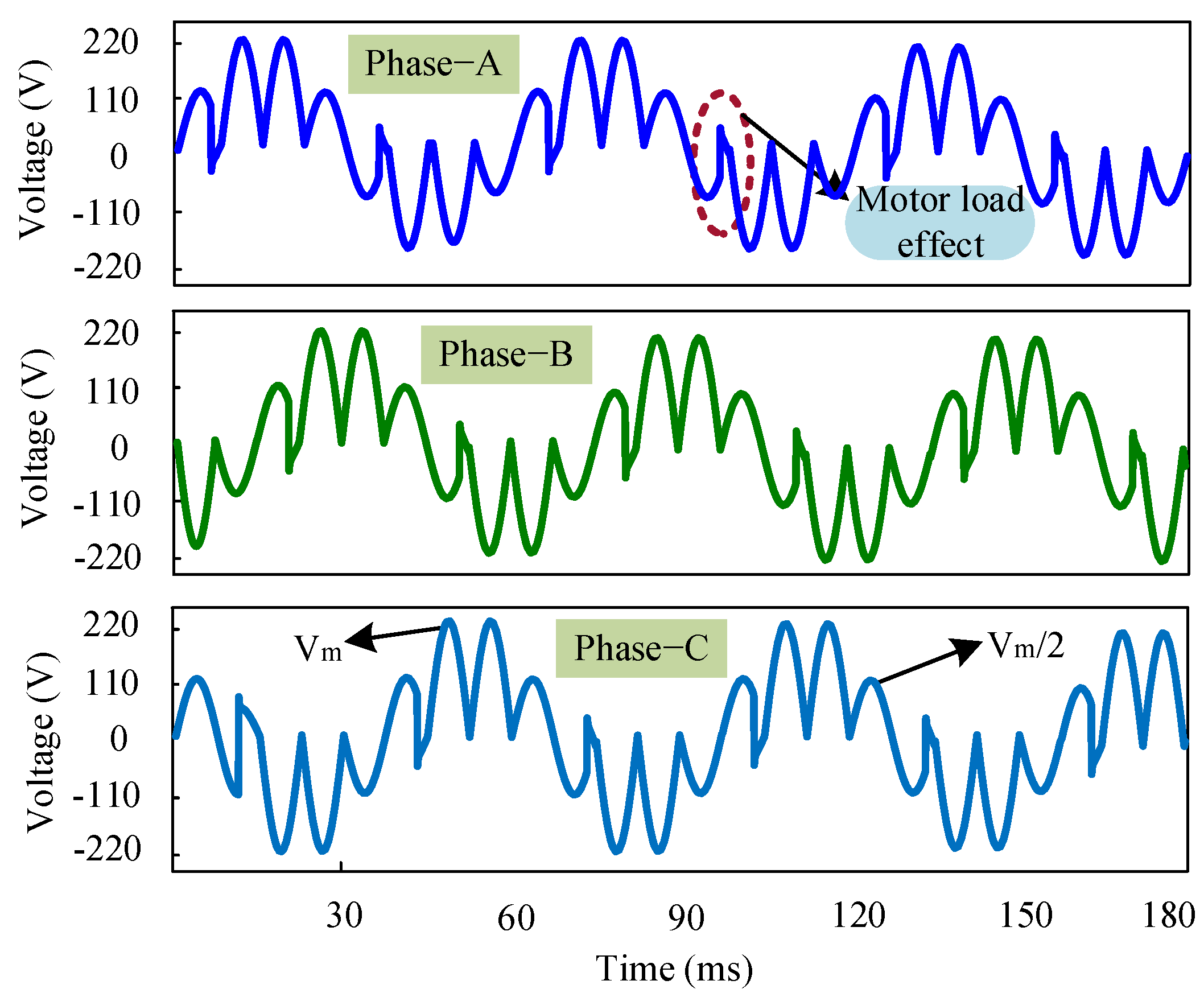

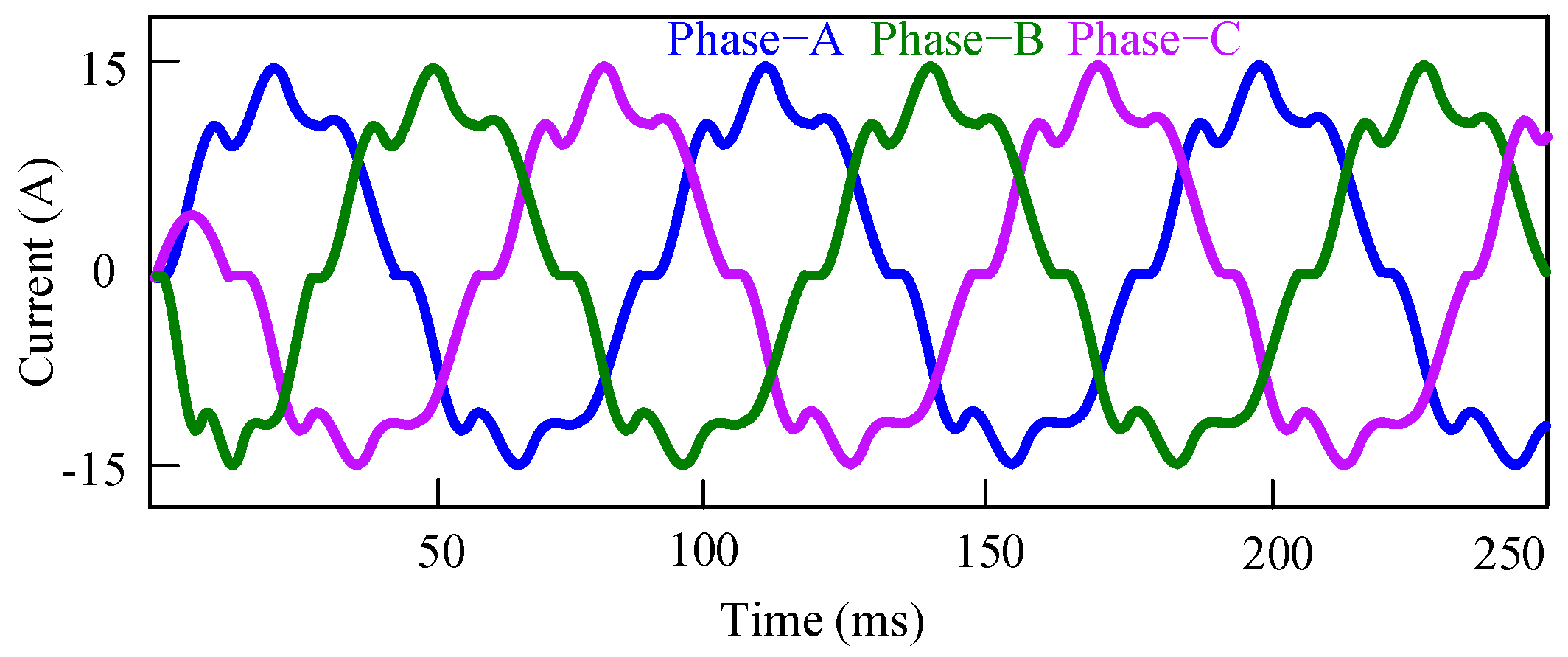
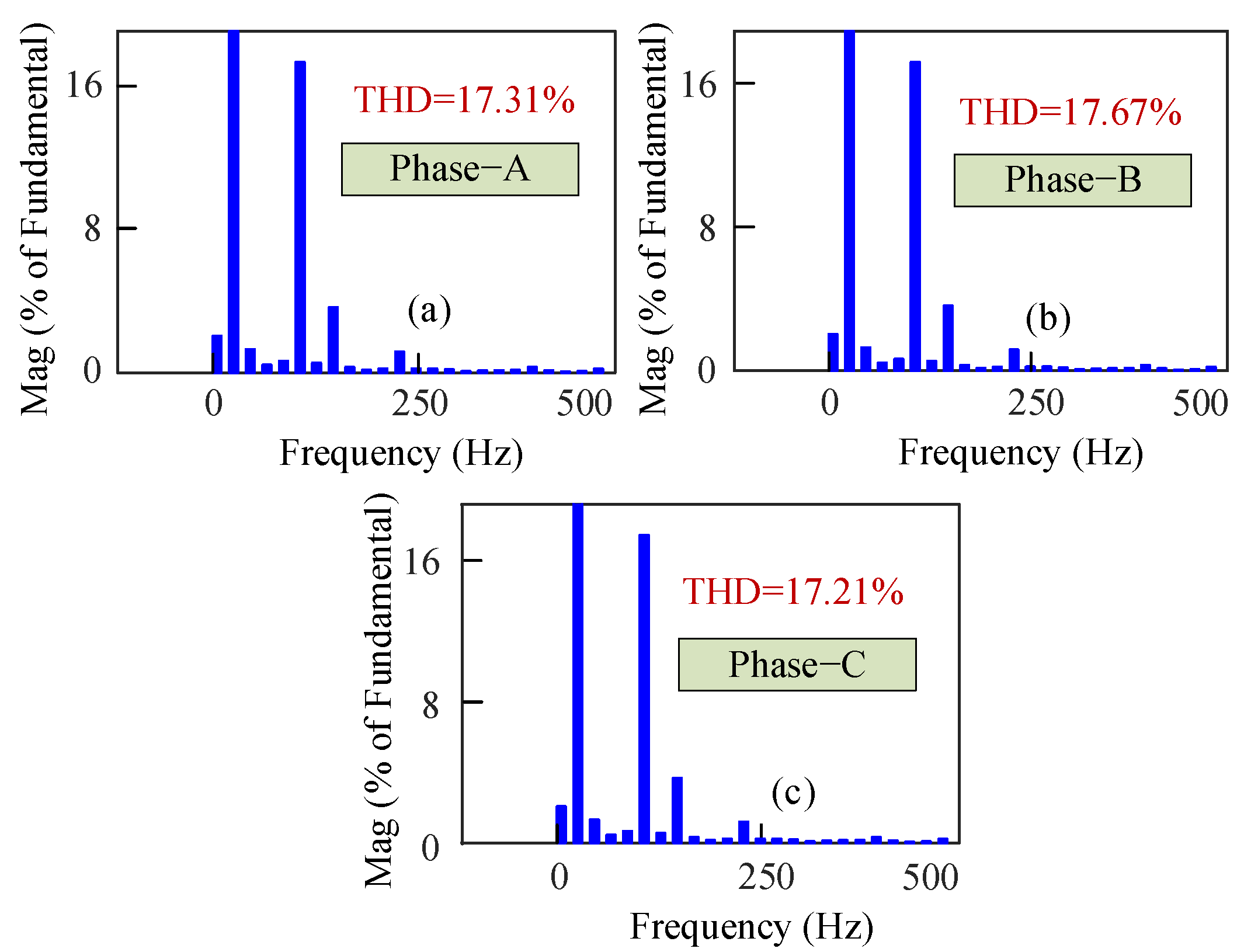






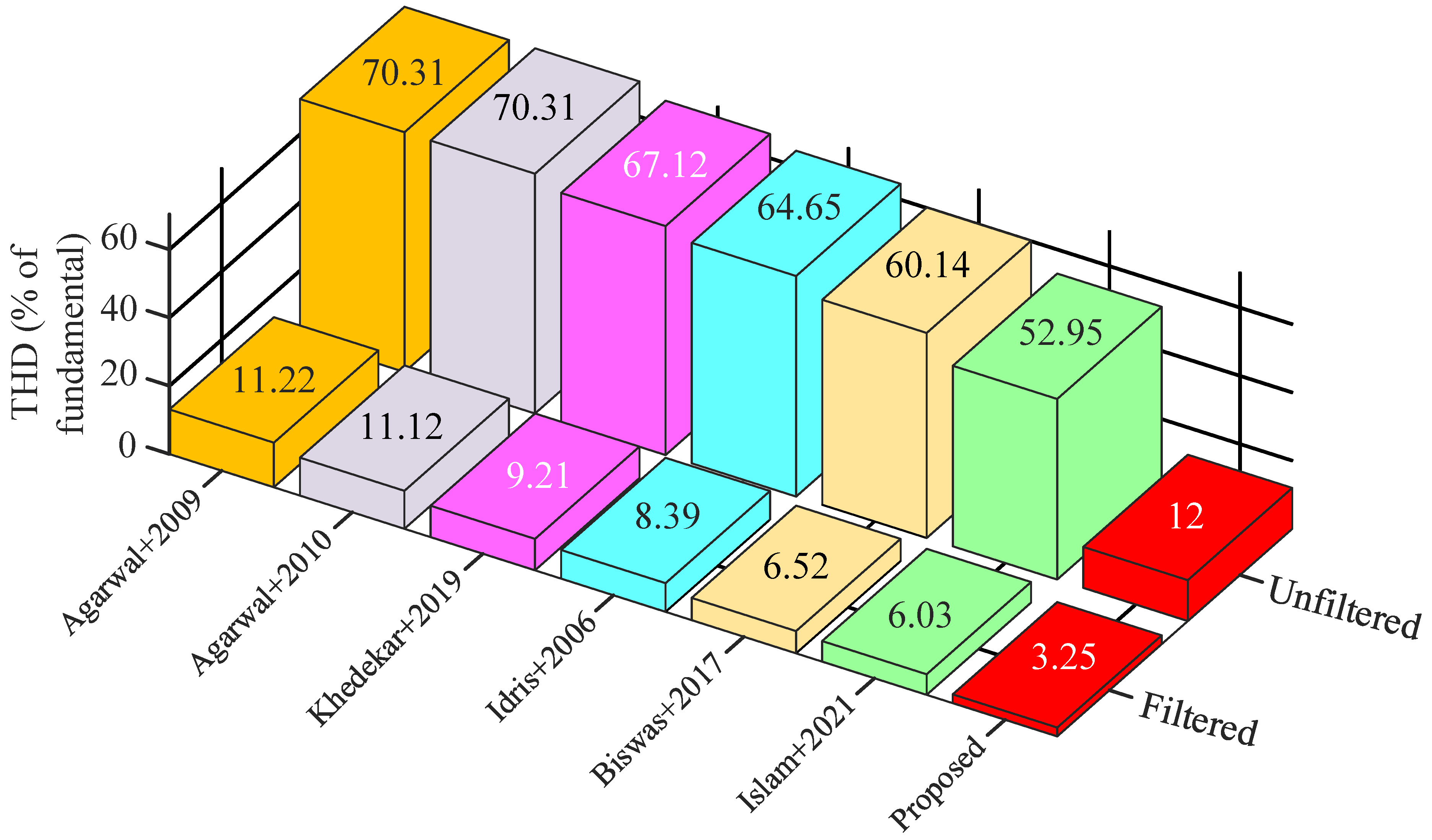
| Output Frequency (Hz) | Mode | Switching State | Output Voltage (V) | |||||||||||||
|---|---|---|---|---|---|---|---|---|---|---|---|---|---|---|---|---|
| Phase | Phase | |||||||||||||||
| A (0°) | B (120°) | C (240°) | A | B | C | |||||||||||
| S1 | S2 | S3 | S4 | S1 | S2 | S3 | S4 | S1 | S2 | S3 | S4 | |||||
| 16.67 Hz (m = 3) | 1 | 1 | 0 | 0 | 0 | 0 | 0 | 0 | 1 | 1 | 0 | 0 | 0 | +Vm/2 | +Vm/2 | −Vm |
| 2 | 0 | 0 | 0 | 1 | 1 | 0 | 0 | 0 | 1 | 0 | 0 | 0 | +Vm | −Vm/2 | −Vm/2 | |
| 3 | 1 | 0 | 0 | 0 | 1 | 0 | 0 | 0 | 0 | 0 | 0 | 1 | +Vm/2 | −Vm | +Vm/2 | |
| 1 | 1 | 0 | 0 | 0 | 0 | 0 | 0 | 1 | 1 | 0 | 0 | 0 | −Vm/2 | −Vm/2 | +Vm | |
| 2 | 0 | 0 | 0 | 1 | 1 | 0 | 0 | 0 | 1 | 0 | 0 | 0 | −Vm | +Vm/2 | +Vm/2 | |
| 3 | 1 | 0 | 0 | 0 | 1 | 0 | 0 | 0 | 0 | 0 | 0 | 1 | −Vm/2 | +Vm | −Vm/2 | |
| 12.5 Hz (m = 4) | 1 | 1 | 0 | 0 | 0 | 0 | 0 | 0 | 1 | 1 | 0 | 0 | 0 | +Vm/2 | +Vm/2 | −Vm |
| 2 | 0 | 0 | 0 | 1 | 1 | 0 | 0 | 0 | 1 | 0 | 0 | 0 | +Vm | −Vm/2 | −Vm/2 | |
| 4 | 0 | 0 | 1 | 0 | 1 | 0 | 0 | 0 | 0 | 0 | 0 | 1 | +Vm | −Vm | +Vm/2 | |
| 5 | 0 | 1 | 0 | 0 | 0 | 0 | 0 | 1 | 0 | 0 | 1 | 0 | +Vm/2 | −Vm | +Vm | |
| 6 | 0 | 1 | 0 | 0 | 0 | 0 | 1 | 0 | 0 | 1 | 0 | 0 | −Vm/2 | −Vm/2 | +Vm | |
| 7 | 0 | 0 | 1 | 0 | 0 | 1 | 0 | 0 | 0 | 1 | 0 | 0 | −Vm | +Vm/2 | +Vm/2 | |
| 8 | 0 | 0 | 0 | 1 | 0 | 1 | 0 | 0 | 0 | 0 | 1 | 0 | −Vm | +Vm | −Vm/2 | |
| 9 | 1 | 0 | 0 | 0 | 0 | 0 | 1 | 0 | 0 | 0 | 0 | 1 | −Vm/2 | +Vm | −Vm | |
| Parameters | Values |
|---|---|
| Nominal power rating | 1.8 kVA |
| TRIAC (Two-thyristors equivalent) | Ron = 0.001 Ω, Vf = 0.8 V, Rs = 500 Ω, Cs = 250 nF |
| Supply voltage | 230 V |
| Supply frequency | 50 Hz |
| RL Load | R = 10 Ω, L = 5 mH |
| Induction motor (IM) | 1.5 hp |
| Stator winding of IM | Rst = 0.6 Ω, Lst = 0.34 mH |
| Rotor winding of IM | Rrt = 0.65 Ω, Lrt = 5.47 mH |
| Mutual Inductance of IM | Lm = 35.4 mH |
| Item | Specification |
|---|---|
| Input voltage (AC) | 230 V, 50 Hz |
| Multi-winding transformer | (28–14–0-14–28) V (1:4 winding) |
| TRIAC | BT136 |
| Opto-coupler | MOC3021, 4N35 |
| Microcontroller board | Arduino Mega (ATMega2560) |
| Load resistor | 10 Ω, 10 W |
| Load inductor | 5 mH |
| Harmonic Order | Conventional 3:1 (m = 3) | Proposed 3:1 (m = 3) | ||
|---|---|---|---|---|
| Fund. % of Output Current (A) (RL Load) | Fund. % of Output Current (A) (M. Load) | Fund. % of Output Current (A) (RL Load) | Fund. % of Output Current (A) (M. Load) | |
| DC Component | 0.00% | 3.22% | 0% | 1.10% |
| 1 | 100% | 100% | 100% | 100% |
| 2 | 0.01% | 4.23% | 0.04% | 0.66% |
| 3 | 30.89% | 37.68% | 0.00% | 0.07% |
| 4 | 0.01% | 4.09% | 0.03% | 0.45% |
| 5 | 28.45% | 40.07% | 12.42% | 16.21% |
| 6 | 0.06% | 5.54% | 0.01% | 0.43% |
| 7 | 8.73% | 12.46% | 3.65% | 3.80% |
| 8 | 0.01% | 2.97% | 0.00% | 0.16% |
| 9 | 0.04% | 3.95% | 0.00% | 0.01% |
| 10 | 0.01% | 2.96% | 0.00% | 0.12% |
| 11 | 2.14% | 2.93% | 0.92% | 1.12% |
| 12 | 0.01% | 3.52% | 0.00% | 0.17% |
| 13 | 1.24% | 0.75% | 0.54% | 0.39% |
| 14 | 0.01% | 0.97% | 0.00% | 0.07% |
| 15 | 0.03% | 1.80% | 0.00% | 0.00% |
| THD | 42.97% | 57.81% | 13.00% | 17.31% |
| Harmonic Order | Conventional 4:1 (m = 4) | Proposed 4:1 (m = 4) | ||
|---|---|---|---|---|
| Fund.% of Output Current (A) (RL Load) | Fund. % of Output Current (A) (M. Load) | Fund. % of Output Current (A) (RL Load) | Fund. % of Output Current (A) (M. Load) | |
| DC Component | 1.90% | 35.79% | 0.77% | 1.62% |
| 1 | 100% | 100% | 100% | 100% |
| 2 | 3.54% | 10.26% | 6.01% | 8.89% |
| 3 | 32.49% | 44.73% | 6.03% | 4.44% |
| 4 | 3.00% | 5.05% | 1.98% | 3.43% |
| 5 | 21.07% | 34.62% | 2.20% | 1.74% |
| 6 | 2.47% | 3.90% | 2.30% | 2.45% |
| 7 | 27.57% | 47.41% | 7.24% | 9.95% |
| 8 | 2.06% | 5.91% | 2.22% | 4.50% |
| 9 | 11.90% | 19.30% | 1.16% | 3.03% |
| 10 | 1.74% | 4.59% | 2.39% | 2.40% |
| 11 | 1.98% | 2.95% | 1.36% | 1.35% |
| 12 | 1.51% | 1.36% | 1.01% | 1.26% |
| 13 | 1.57% | 2.24% | 0.85% | 0.90% |
| 14 | 1.32% | 2.99% | 0.76% | 0.69% |
| 15 | 2.69% | 2.97% | 0.61% | 0.91% |
| THD | 49.82% | 78.09% | 12.00% | 16.35% |
Publisher’s Note: MDPI stays neutral with regard to jurisdictional claims in published maps and institutional affiliations. |
© 2022 by the authors. Licensee MDPI, Basel, Switzerland. This article is an open access article distributed under the terms and conditions of the Creative Commons Attribution (CC BY) license (https://creativecommons.org/licenses/by/4.0/).
Share and Cite
Biswas, S.P.; Uddin, M.S.; Islam, M.R.; Mondal, S.; Nath, J. A Direct Single-Phase to Three-Phase AC/AC Power Converter. Electronics 2022, 11, 4213. https://doi.org/10.3390/electronics11244213
Biswas SP, Uddin MS, Islam MR, Mondal S, Nath J. A Direct Single-Phase to Three-Phase AC/AC Power Converter. Electronics. 2022; 11(24):4213. https://doi.org/10.3390/electronics11244213
Chicago/Turabian StyleBiswas, Shuvra Prokash, Md. Shihab Uddin, Md. Rabiul Islam, Sudipto Mondal, and Joysree Nath. 2022. "A Direct Single-Phase to Three-Phase AC/AC Power Converter" Electronics 11, no. 24: 4213. https://doi.org/10.3390/electronics11244213









